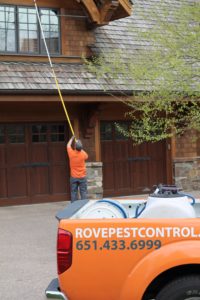If you have recently watched any Hollywood portrayals of pests needing to be killed, you are likely familiar with the term Exterminators. Since most companies in this pest killing industry include the term pest control in their name, which term is correct? Do they mean different things? Let’s explore the ins and outs of the terms pest control vs exterminating.
Pest Control vs Exterminating – The Verbiage
In most situations, pest control and extermination are synonymous. Generally speaking, they both refer to a situation where an organism is present but unwanted. Some pests threaten health, have economic implications, or simply be ruin aesthetics. The bottom line is that it is an unwanted organism. Whether you call an exterminator or a pest control operator, you will get helpful service.
Exterminating as a term typically sounds outdated. Some individuals as service providers or consumers prefer the feel of finality that accompanies the exterminating term. But, most of the industry gravitates to pest control. The term pest control has less finality associated with its inherent etymology, but it also carries broader concepts and applications.
One of the reasons that companies avoid extermination is that it can be a misleading term. If someone wants their mice exterminated, they are likely envisioning no mice being left after the process. The reality is that even with the most efficient mouse removal efforts, mice will be around somewhere. The idea is to make sure the population is under control with regard to size, but also to access. It is ok for a mouse to run around in the woods behind the home. It is not ok when it decides to come inside for a snack.
Pest Control vs Exterminating – The Process
In some instances, pest control as a term may refer to keeping populations in check. Exterminating may refer to completely ridding a given area of a certain pest. For example, if someone is dealing with bed bugs parasitizing them in their sleep, complete eradication of the population from the dwelling is a likely goal. On the other hand, ants may be more about control. Control as in keeping the population down to a level that is not harming or bothering anyone as well as keeping barriers up to stop them from entering places where they are unwelcome.
Pest Control vs Exterminating – The Ecosystem
In most cases, nature has a natural balance in the various populations, however, sometimes things will interfere. For example, building homes close together with well-kept grass and boulder retaining walls may create an ideal living situation for a vole, but make it harder for natural predators such as owls to have as good of a chance at hunting them. In this situation, the voles may need pest control measures applied to keep the population in check. Depending on the situation, control may be fine or extermination may be necessary.
Some pests carry such strong stigmas with them that people automatically jump to wanting them completely exterminated. With all of the economic damage done by termites, most people assume any termite anywhere should be exterminated immediately. This is not always the case though. Termites serve a role in nature of taking care of dead fall that could cause other problems. A small family of termites out in the woods wouldn’t need to be destroyed, but simply monitored for signs of approximating to a nearby home. Sometimes pest control simply means monitoring a pest for indications of further efforts needed.
Pest Control vs Exterminating – The Migratory
In some situations, animals such as bats and butterflies may seem overwhelming in numbers, but it is important to remember some animals are migratory and just passing through. Extermination efforts may disrupt normal population needs and endanger beneficial creatures. In the case of bats, an option for non-lethal control is installing bat houses. This can provide them with a place to roost where it won’t bother the home or people dwelling there.
IPM
Integrated pest management is the newer term on the block. It is not likely to become a popular word with regular consumers who simply want their pest situations resolved quickly, but it is a driving force within the pest control industry. Essentially, it is the method of examining all environmental factors that play into a pest situation and choosing the solution or combination of solutions that have the best overall result. With some pests, this may be reducing moisture and humidity levels. With others, it may be installing a barrier. IPM seeks the best and most efficient results through pest control operators and consumers working together to achieve and maintain results.
Get A Free Consultation
Don’t feel like you need to be the expert on the best approach to a given situation. The experts at Rove Pest Control are available to walk you through the process and put together the best plan of attack for your situation.
